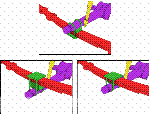Because of the mechanical nature of suspension, all sorts of mods are available. Lifting suspension is a popular mod used to try to increase ground clearance. This is often a source of misunderstanding. A lift kit doesn't really give you more ground clearance. What it does is increase the height between the axle and the underside of the body. Whilst this does give more ground clearance for the bodywork, the lowest point on the vehicle is still the axles - or on a 4-wheel-drive, the bottom of the transfer case. For this reason, you'll often see trucks and SUVs with lift kits and larger wheels and tyres. The lift kit boosts the clearance under the bodywork whilst the larger wheels and tyres result in the axles being lifted higher off the ground. Technically of course, in a 4-wheel-drive, you don't really need a lift kit - bigger wheels and tyres would do it. BUT lift kits typically end up being required because adding on the larger wheels and tyres can often mean they will no longer fit in the wheel arches. The lift kit will help solve that problem.
Lift kits come in literally hundreds of shapes and sizes, all dependent on the final application as well as the design of the vehicle the kit is going to be used on. For street cars, typically with independent suspension, the kit will basically be longer struts, longer springs and remounted shocks. For off-roaders with beam axles and transfer cases, the suspension system is typically leaf-spring, so the kit will be a set of blocks that fit between the beam axle and the bottom of the leaf spring. Alternatively, some kits have blocks which lower the spring mounts themselves so that the spring-to-axle joint isn't changed. The image below shows an example of a typical leaf-spring beam-axle suspension system along with two examples of how it can be raised.
Fitting a lift kit is pretty basic engineering but it's really difficult to do without access to a hydraulic lift, so its best to either get a garage to do it, or to find a mechanic friend who has a decent sized hydraulic lift. Trying to mess with the suspension whilst a vehicle is on the ground is just asking for trouble.
h2Speaking of trouble.../h2
Lifting a vehicle is going to affect its handling. Most obviously, you're going to add height to the centre of gravity, which in turn is going to make the vehicle more prone to roll in corners. At the extreme, an already roll-happy SUV or truck will become even more likely to turn over in the event of an accident.
Similarly, just because you've lifted your truck, don't think you can instantly go off-road with it like a pro. If you're doing it for off-road functionality rather than just pose value, spend the extra cash and get a one-day off-road course. You'll have a blast and it will make you infinitely safer when you do take your vehicle off the beaten track.
It's also worth pointing out that putting larger wheels on simply to increase ground clearance can come with all its own problems including the legality of it, changes to the steering and suspension geometry and steering load. It's also a possibility on some types of 4WD vehicle that larger tyres and steering load can result in tearing the steering box off the chassis. Other things which tend to fail quicker when this is done are items like pitman arms, track rods, knuckle and ball joints - all of these get stressed beyond their normal design limits when you stuff massive tyres and wheels on a truck.
One other point to consider when doing this: if your speedometer is based on a mechanical link to the gearbox, your speedo will become so innacurate that it will basically be useless. You'll be driving at an indicated 30mph but could be doing 40mph if the tyres are big enough.
Just be warned.
